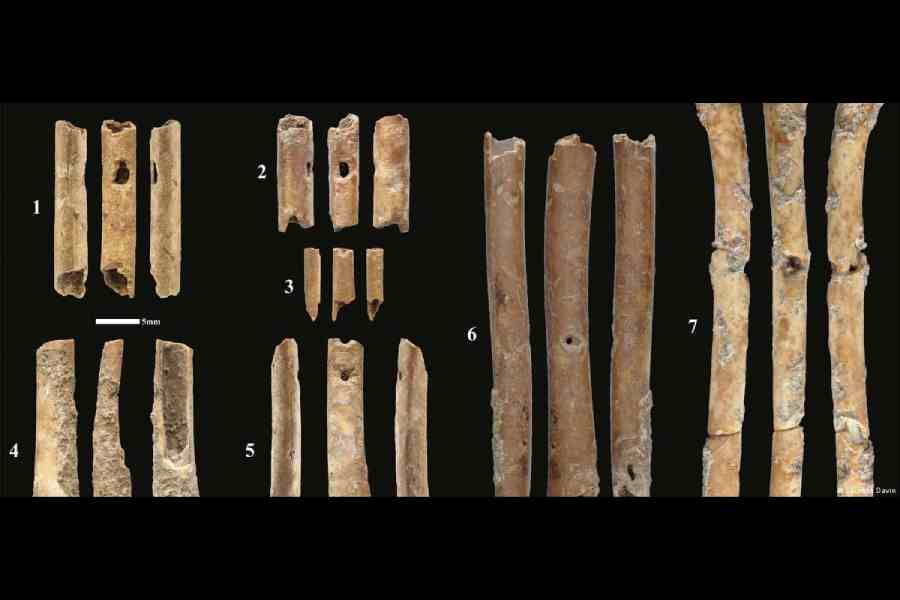Between 10,000 and 12,000 years ago, Stone Age humans started transitioning from hunter-gatherer to town-dwelling farming societies.
Human culture changed forever, with art, music and rituals at the heart of the shift, offering new ways to bind people together in shared religion and purpose.
But while symbolic cave paintings and ornamental jewelry survived for us to see for ourselves, music and dance faded away.
Now, archaeologists in Israel have discovered a set of 12,000-year-old Paleolithic musical instruments from the Natufian people. The flutes mimic the sound of falcon calls and could have been used in spiritual music rituals.
Replicas of the flutes offer insight into what they sounded like. Spoiler alert, it might set your teeth on edge.
"It was really nice when we first heard it — it's a sound from 12,000 years ago," study lead author Laurent Davin, an archaeologist at the French Research Center in Jerusalem, Israel, told DW.
Living 15,000 to 10,000 years ago, the ancient Natufian people were at the forefront of humanity's shift to agriculture.
Early humans had been following the seasons and hunting stock for hundreds of thousands of years, but the Natufians were some of the first people to show sedentary traits, staying in one place to form farming and herding societies.
"They lived in open-air settlements but also used caves for specific, most probably cultic/public activities. This is the first society to have solid, stone-based architecture, and not less important, the first graveyards, with special treatment of the dead," said Anna Belfer-Cohen, a Paleolithic archaeologist at the Hebrew University of Jerusalem in Israel.
Archaeological evidence shows Natufians buried leaders and shamans in elaborate gravesites rich with offerings of eagle's wings and other animal remains. This special, ritualistic treatment of the dead and their graves would become one of the most important developments in human culture — religion and spirituality.
Researchers believe that music and art allowed the voices of the dead and animal spirits to be heard and re-heard through rituals passed through generations.
Over time, their stories became mythologized, blending with tales of genesis and heroism as well as music and artistic symbolism used to metaphorize the deeds and characters of great people.
Some even became gods that bound societies together around central authoritative figures.
"I am sure music played a dominant role in the life of the people from the very beginning, even when the findings relevant to this are unfortunately rare," said Belfer-Cohen.
While the cultural importance of music was well-established in Stone Age society, Davin's study, published in Scientific Reports, offers the first concrete evidence that Natufians were musical.
Excavations at Eynan-Mallaha near the Sea of Galilee unearthed over 1,100 bird bones from the settlement dating between 10,730 and 9,760 BCE. Davin and his team reanalyzed the bones, finding many were actually "aerophones", or small, flute-like instruments.
While not the oldest instruments ( 40,000-year-old-flutes were once found in Germany), they are the oldest found in the Levant.
The Natufian flutes were all made of wing bones of small birds like the Eurasian Teal, Eurasian Coot and ducks and mallards. The flutes are tiny — 6 centimeters (2.3 inches) long and 1 centimeter wide. Each flute has between one and four finger holes as well as a mouthpiece.
Curious what the instruments sounded like, Davin and his team reproduced three of the instruments made from the wing bones of two female mallards.
The tone produced is a high-pitched note that sounds almost like a bird of prey. Speculating the flutes could have been used to imitate bird calls, the team played the instrument and analyzed the sound. They found that the sounds produced by the replica flute were remarkably similar to the calls of kestrels and sparrowhawks.
"It was a complete match. So the idea is that the flutes were made to imitate the calls of falcons," said Davin.
The authors think the use of small bird bones was deliberate. Though more difficult to play, narrower diameter wing bones produced the required high-pitched sound.
"They could have used bones from bigger bones, but they didn't, probably because they knew the thinner the bone, the higher the pitch of the tone. They probably had some knowledge of acoustics," Davin told DW.
The Natufian flutes all had traces of contact wear around the finger holes, indicating people had played the instruments. But what were the flutes used for? Davin and his team can only speculate, but it's possible the flutes were used in rituals with spiritual or quasi-religious meaning.
Davin points to contemporary evidence of the symbolic meaning of birds.
The Plains Indians in North America, for example, held communal religious ceremonies in which they blew similar whistles made from eagle bones decorated with feathers. Similarly, Kaluli people in Papua New Guinea wear the feathers of rainforest birds which are considered to be spirits.
"The plains Indians want to communicate with eagles to take their strength. The relationship is symbolic," said Davin.
Another idea is the flutes were used for hunting falcons, or even hunting with falcons using falconry.
"These are people who were also hunters. Another function of the flutes offered by the authors is that they could have been used to trap or hunt birds — maybe not for their flesh but for their feathers and claws," said Belfer-Cohen.
It's clear that animals had tremendous spiritual importance for early Neolithic and Palaeolithic societies. Music and art were used to metaphorize the spirits of animals, the hope being to call upon their strength, both in life and death.
"People were dependent upon their immediate surroundings and special ties with the natural world around them. Association with animals could be observed in the Paleolithic most obviously through the art produced, like what humans depicted on the walls in the times of the Upper Paleolithic on the walls of the Franco-Cantabrian regions (France and Spain)," said Belfer-Cohen.
And we still see the roots of these animal metaphors today in the flags of countries and sports teams with eagles and lions, in the pseudoscience of zodiac signs written in daily newspapers and in descriptions of people as cheeky monkeys or sly foxes.










